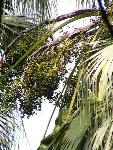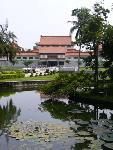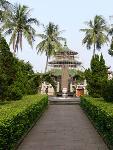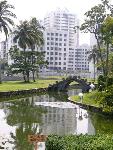- Getting around Lijiang. Dont stay in the Old Towns more than 2 days, there is nothing to do. KRISS Oct 9, 2013 05:46
- 2013 Beijing Temple Fair BENNYLAU Feb 26, 2013 03:29
- Malaysian traveling from KUL - LAX vis Shanghai PVG ZATI_DY Jan 3, 2013 20:15
Historically Haikou
- Views: 6163
- |Vote: 1 0
- |Add to Favorites
- |Recommend to Friends
Black Coffee, Island Jungle
My perfect little white room in the New Hong Kong City Hotel felt just like a Pacific Islands resort from inside, with cane trimmings and furniture that had an air of island culture about them, and I almost could imagine that I could step straight outside onto the beach – that is, until a glance out of the window sobered me to the fact that I was on the nineteenth floor above one of China’s largest cities. Even still, you could almost sense the proximity to the ocean, and the forest of palm trees below lining almost every street confirmed the fact that this was indeed the tropics; Hainan is precisely that kind of white sands destination people go crazy for – and one that still manages to be definitively China in every way. Being a big fan of both China and island countries, it really was my kind of place.
One other major drawcard Hainan has for a Western tourist like me is a substance that is almost universally revered in the West not only as a vital part of every waking day, but also as an important component of culture and civilised behaviour. It is the pick-me-up of choice for almost every Westerner – coffee. We’re not alone on this: Africans and Middle Eastern people live off the stuff too, and in a recent trip to Vietnam I found that over there they enjoy some of the best coffee in the world (caffeine fiends take note) – but in China, it’s never been a hit – and the recent proliferation of coffee in big Chinese cities is more fashion than anything else. Besides, any Westerner will tell you that the coffee you buy in China is generally, sorry to say, not that good.
Not so in Hainan, mainly because coffee is grown on the island in large quantities. If you ever do buy Chinese coffee beans, they’re almost certainly grown in Hainan Island – and the industry has, over the years, seen a number of addicts to the brew emerge in the province of paradise. When I finally decided to go outside and face the day, I skipped across the road to the upper-story café and picked up a strong coffee to go, and then wandered along to a bakery I’d noticed the night before to get some French croissants and coconut tarts. In China, that is paradise.
I decided to enjoy my breakfast outside, and headed straight for the city’s central park, just a short walk away from my hotel, known simply as Haikou Park. Huge blue-painted corrugated iron walls encircled the park of the kind you normally see around big construction projects in China – Beijing is currently a sea of blue corrugated iron as the city builds several new subway lines – and so I worried for an instant that the park was at least closed or at worst being developed into apartment blocks. But I found a small entrance to the rear, and slipped inside.
I didn’t discover the reason for the corrugated iron partitioning, for I couldn’t see any sign of work going on in the park at all – what I did see was a thick, jungle of palms and other dark green tropical trees growing in wild abandon inside. Thin pathways worked their way through the imposing mass of trees, and before too long I really felt lost in primordial, untamed Hainan. It was a pleasant contrast to the kind of limp, mown-grass, organised shrubbery style park you see in most places, and when I came across a little white stone frame in the middle of it all, I had found the ideal location for enjoying my morning poison.
The Exiles
Of course, Hainan hasn’t always been the destination of choice for Chinese people – in fact, quite the opposite. For years it was considered the most backward and vile place on Earth, and the Emperors of successive dynasties used it as the ideal location for the banishing of officials who displeased them, making of the island a kind of paradisiacal prison. Although I considered that if I had been an official in a Chinese court, I’d have liked nothing better than to fall into disgrace and be banished to Hainan, it seems that the poor souls in history to whom this actually happened found no beauty in the pristine beaches and bounty of coconuts, and described the place as ‘the gate of Hell’.
There’s a respectable museum on the subject in the southwestern district of Haikou near Qiongshan, called the Wu Gong Ci – the Memorial Temple for the Five Officials. The officials referred to in the name are respectively Li Deyu, Li Gang, Li Guang, Zhao Ding and Hu Quan – all of whom were for some reason or other sent to this remote island by Emperors ranging from the Tang to the Song dynasties. Not only is this hapless quintet immortalised here, but also, and more importantly, a poet who was similarly banished but who earned deep admiration from the locals after drawing much-needed freshwater wells from the land, and for bringing some culture to the wasteland. The museum features some historical buildings dedicated to the poet, Su Dongpo, who died on his way back to civilisation just after being released from his Hainanese exile, and tells of the schools of learning that were founded in his memory.
There’s a bus route that goes directly from the hotel to the temple, but I didn’t get on it and instead boarded another that I was wrongly advised was faster. The bus, in what I was to learn was typical of Hainan’s crazy routes, switched direction a couple of times and ended up quite far from where I was headed – I had to resort to taking a taxi. Finally, however, I arrived and was quite satisfied to see the impressive buildings from the roadside.
Upon entering, I had to admit to being a little disappointed. The old halls dedicated to Su Dongpo are interesting enough – peaceful little places with the ancient springs still brimming with fresh water, and the occasional verse of Su Dongpo’s poetry. The site is ideal for relaxing after a hot morning spent on the island. However, the main, officious looking building – a historical wooden construction with ostentatious roof ornamentation and several imposing halls – was frankly dull. Foreigners won’t find anything in English, which is fair enough, but even if you can understand Mandarin, the history recounted is passionless and overdetailed, the exhibits unimaginative and colourless – and a ponderous side museum of Party history failed to win any points with any of the visitors to the museum – which only managed to hold their attention for fifteen minutes at the most. There’s a hall of dug-up exhibits upstairs, containing a few pieces of pottery and very little else. For such a beautiful building, one wishes that the museum’s curators had made a little bit more effort.
Haikou’s Number One Citizen
Quite different is the tomb of the sorely missed and much admired Hai Rui, situated close to the extreme other end of the circuitous number 1 bus line that passes Wu Gong Ci and the New Hong Kong City Hotel before ending up here. The tomb park is only of modest size, but the attractiveness of its design makes it probably the most appealing destination for seekers of Haikou’s historical remnants.
Hai Rui was one of those rare officials who was actually also a good guy. Born in the middle of the Ming Dynasty, he was always willing to represent the downtrodden and speak out for the underdog. He was impeccably honest in character, garnering respect in his lifetime and reverence after his passing, and earning a fine tomb worthy of royalty.
The tomb has a hundred-metre pathway leading to the mound beneath which he is buried, with traditional stone animals and servants along the sides representing blessings in the afterlife. What is really the star attraction of the tomb, however, is the three-storied temple erected behind the grave itself – and the small lake before it. The temple is built in the style of the Temple of Heaven in Beijing, a massive, circular construction that is very impressive to look at and that makes for some stunning photographs – although I was unlucky that at the time I was visiting, the temple was under renovation and surrounded by scaffolding. Visitors to China who don’t have the opportunity to see the temple of Heaven in Beijing may find this location a good alternative if they’re coming to Hainan, and this temple has the advantage in that it’s actually possible to enter inside and climb to the top, form which a pleasant view of the gardens and the city beyond is visible.
I found the tomb to be far more inspiring than the dull Wu Gong Ci – because it really does bring to mind the rarity of truly good men, and shows the legacy that honest, moral people can have. Next to the tomb is a larger park and a school named after the man, and one is led to suspect –as did Chairman Mao, who spoke to this effect – that were there only more figures around like Hai Rui, China’s future would be bright indeed. We can only hope.
TRAVEL INFORMATION
The beautiful HONG KONG CITY HOTEL is an ideal place to stay. The eager YTS travel company set up on the fifth floor - a few doors down from a relatively cheap Internet Cafe - may approach you as you disembark the ferry from Beihai if you're arriving that way. They offer a cheaper rate than is advertised on the price board.
HONG KONG CITY HOTEL: 香港城大酒店
http://www.china0898.com/
china0898@163.net
30 Datong Road, Haikou City - 0898-36391717
YTS Travel Service 0898-36386666/36381199
WU GONG CI 五公祠
169 Haifu Road, Haikou City - 0898-65353047
Current Price: Peak RMB30 off-peak RMB20
HAI RUI TOMB 海瑞墓
Shugang Dadao, Haikou City - 0898-68922060
Current Price: RMB10







 Copyright © 1998-2026 All rights reserved.
Copyright © 1998-2026 All rights reserved.